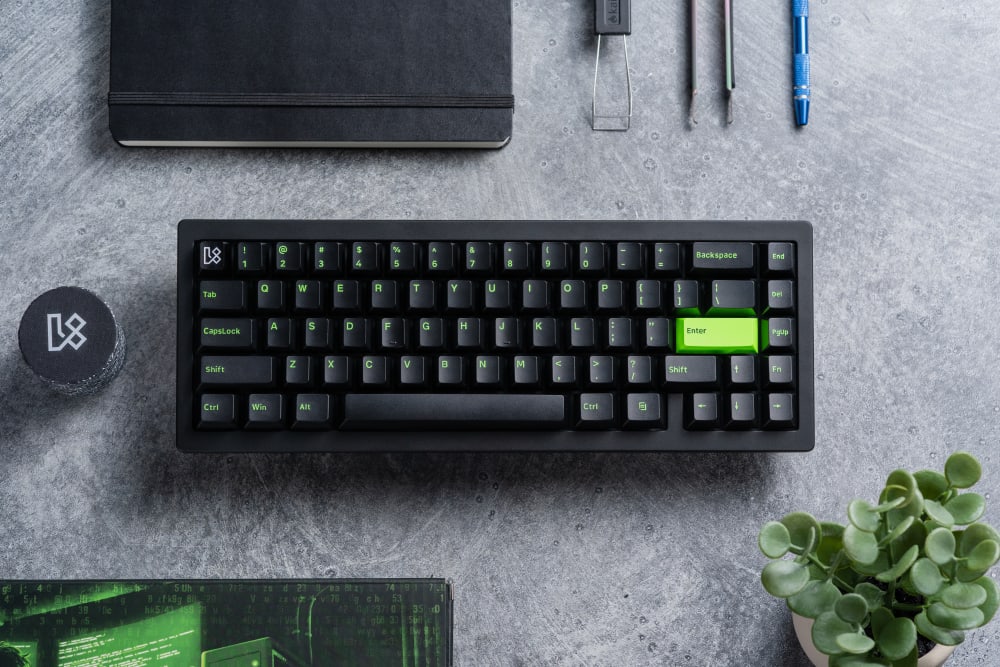Preston S.
May 4, 2023
•3 minutes
Comparing Mechanical Keyboard Plate Materials
Mechanical keyboards use a variety of different plate materials, including PC, FR4, and Aluminum. In this guide, I review several options to help you choose.


Keychron Q5 Barebones
There are plenty of different plate options to choose from nowadays for your mechanical keyboard, but each plate affects the sound and feel in one way or another so how do you know which one to choose?


Brass Plate on Squid60
Firstly, there are two categories of plate materials, Dense (stiff) materials like steel and brass, and less dense (flexible) materials such as carbon fiber, FR4, POM, and Polycarbonate. When it comes to the dense materials, they provide a stiffer typing experience with basically no flex and have a harsher bottom out due to the material. They also resonate a lot, and provide a higher pitch sound profile to your keyboard.
Brass plates are very popular when using tactile switches as the typing experience is quite nice and has a very solid feel to it. Steel plates are my least favorite as they are usually found in a lot of budget keyboards, but have a lot of ping to them, and can be quite difficult to work with in terms of removing the ping.


TG67 V2 with a PC plate
When it comes to the less dense materials, POM and Polycarbonate are probably the most popular on this list as they are known to give your keyboard a deeper, and sometimes thocky sound signature. People also really like the flex these two plates have as they can provide a less harsh bottom-out experience leading to a nicer feeling typing experience overall. The TG67 V2 mechanical keyboard is an example of a board with a PC plate.
FR4 is your go-to plate if you are looking for a more neutral sound profile as the plate is made out of the same material as the PCB. FR4 is a bit stiffer than POM and Polycarbonate, but still has a nice flex to it so it still provides a great typing experience as well. Carbon fiber plates tend to be the stiffest plate you can choose when comparing them to their less dense counterparts. It also provides a higher pitch sound as well and I just find it to be a worse version of FR4, but I’ve also heard plenty of sound tests where it doesn’t sound bad so your mileage may vary.


Carbon Fiber Material
Overall there are a lot of plate materials to choose from, and it might seem confusing so if you wanted to keep it simple, get brass or steel if you wanted a stiff typing experience, and go for polycarbonate, POM, or FR4 if you wanted a more flexible typing experience.
Frequently Asked Questions
These are some of the most frequently asked questions I've received regarding keyboard plate materials:
- Does a mechanical keyboard need a plate?
- In the majority of cases, your keyboard needs a plate unless it explicitly states that it is a plate-less build, which are usually always soldered to prevent switch wobble.
- Which plate is best for mechanical keyboards?
- The best plate for your mechanical keyboard ultimately comes down to personal preference, but the three most popular options are aluminum, PC (Polycarbonate), and brass.
- What is a plate on a mechanical keyboard?
- A plate on a mechanical keyboard is the layer that sits on top of the PCB (Printed Circuit Board), that holds your switches in place and provides support.
- What are the different types of plates for mechanical keyboards?
- There are many different types of metal and non-metal plates, but the most popular are: aluminum, PC (Polycarbonate), brass, steel, FR4, POM, and carbon fiber.
- Should I get a metal or plastic plate for my keyboard?
- The material of your keyboard plate comes down to personal preference, but as a rule of thumb if you are looking for a deeper, more muted sound, you should go with non-metal materials such as PC and FR4.